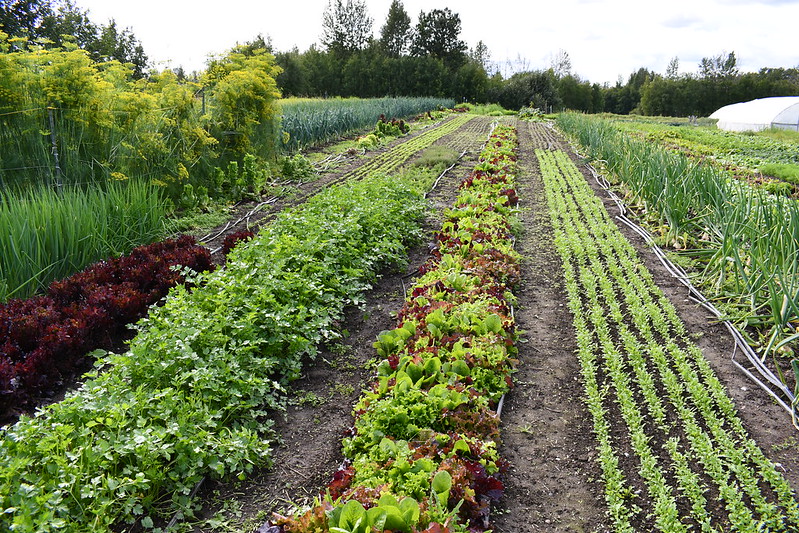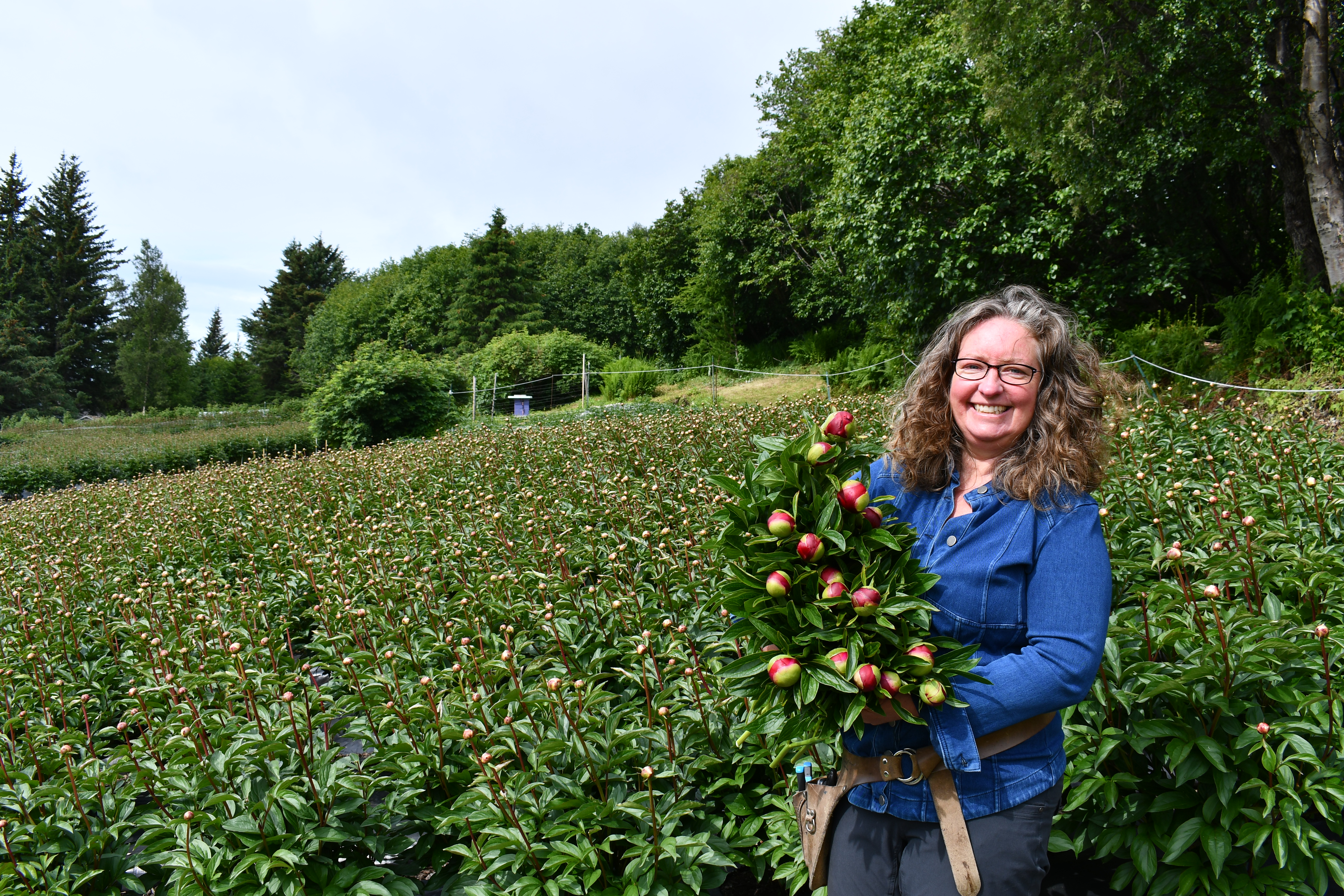
Alaska is the largest U.S. state, yet it has one of the smallest agricultural industries. Alaska Natives and many small communities depend on wild harvest resources for food security and cultural connection to the land and sea. However, local food supply does not yet meet demand. As such, Alaska relies heavily on imported food and is thus more vulnerable to interruptions in the food import supply chain. More Alaskans are farming than ever before, and Alaska has the highest rate of new and beginning farmers in the U.S. The growing interest in farming is helping to meet the need for locally sourced food in the state.
What do Alaskan farmers produce?
Alaskan farmers produce meats, vegetables, grains, and fibers. Alaskans already produce a wide variety of plants and livestock, and crop diversity is expected to increase in a warmer and wetter climate.
- Farmed fish lead sales of meat products, followed by cattle, hogs, sheep, goats, chickens. Reindeer, bison, muskoxen, and yak are also produced.
- Aquaculture is expected to benefit from increased temperatures and milder winters.
- Seaweed farming (e.g., bull kelp) can be a sustainable source of food and revenue that benefits marine ecosystems in Alaska.
- Alaskans produce a wide variety of vegetables, berries, apples, potatoes, melons, dry beans, and grain.
- Alaskan farmers also produce nursery, greenhouse, floriculture, and sod products, including Alaska peonies.
Producers in Alaska already contend with and adapt to many climate challenges, which are expected to increase with climate change. Occasional frosts during the growing season damage crops. During droughts or other extreme weather events (when the wildlife food supply is limited), wildlife will search for food on farms, potentially causing damage and increasing wildlife-human interactions. Other challenges experienced state-wide include insect pests, soils that need fertilizer to support plant growth, limited infrastructure, and long supply chains that result in higher costs and smaller markets. Under warmer and wetter future conditions, agricultural production levels could increase, and different products may be grown.

How could climate change affect agriculture in Alaska?
Agriculture is likely to be positively and negatively affected by climate change in Alaska, with varied impacts on food security. Historically, agriculture in Alaska has been limited by short growing seasons, cool summers, and very cold winters. As a result, the agricultural industry in Alaska is small, producing primarily cold-hardy crops like hay, barley, potatoes, carrots, and kale. Currently, only 5% of the food Alaskans consume is produced in the state.
However, climate models suggest a different future for agriculture in Alaska. By 2100, the frost-free season is expected to extend by weeks, summers and winters are expected to be warmer, and growing degree days (a measurement used to determine how much heat is available to crops) are likely to double or triple throughout the state. These changes are likely to lengthen the growing season and cause dramatic shifts in Plant Hardiness Zones (a USDA standard by which growers can determine which plants are likely to thrive at a given location). For example, the current zone in Palmer, Alaska is 5a. By 2100, Palmer is expected to shift to Zone 7a, the current zone in places like Boise, Idaho and Kennewick, Washington.
Although increased temperatures will improve suitability for agricultural production in Alaska, climate change also comes with an increased risk of variable weather, more intense storms, potential increase in invasive plants, insects, and diseases, more wildfire, and changes to water timing and availability. Additional effects of climate change on agriculture in Alaska are projected to be:
- Longer growing season. Warmer temperatures are leading to more frost-free days. Longer growing seasons benefit certain crops and may allow for new and different species and varieties to be grown in Alaska. A long growing season creates an opportunity for farmers to increase the diversity of crops and meet local demand for Alaska-grown produce.
- Crop yields may be improved or degraded. Increased temperatures will shift the growing season by altering the timing of germination, harvest, and storage, which may impact crop yield in positive or negative ways depending on the crop and preparation by the farmer.
- Increased pressures from weeds and invasive plant species. New plant species may migrate to Alaska with changes in climate.
- Pests may increase. With increases in temperatures, populations of insects that overwinter may increase earlier in the season, and new insects and diseases may establish in the state. Also, shorter winters will bring an earlier arrival of migratory insects, which may allow for more generations of pests within a season.
- Increased risk of plant pathogens. Increased temperatures can support pathogen survival over winter, lengthen the period of infection potential, allow for more infection cycles within a season, and result in pathogen populations expanding into new areas.
- New varieties of specialty crops that thrive under longer growing seasons, lower frost risk, and warmer temperatures are beginning to expand. Farmers and gardeners are already wondering what else they can grow as these changes unfold. Bushes Bunches Produce Stand and Ridgeway Farms are examples of farms implementing climate adaptation actions in Alaska.
- Livestock production, particularly of native, cold-adapted species, may need to expand into cooler, drier regions of the state as conditions continue to warm.
Despite the challenges posed by climate change, a growing agricultural industry offers hope for Alaska's future food security. As the climate warms and the growing season lengthens, new opportunities arise for cultivating a wider variety of crops and raising livestock. By embracing innovation and adaptation strategies, Alaskan farmers can play a crucial role in ensuring a more sustainable and self-sufficient food system for the state.
The Adaptation Resources for Agriculture in Alaska workbook includes information on climate change adaptation tactics for improving agricultural responses to extreme and uncertain conditions throughout Alaska.
Climate Outlook Briefing webinars by the Alaska Center for Climate Assessment and Policy help to prepare producers for future climatic conditions.
The Alaska—Fourth National Climate Assessment discusses marine ecosystems, terrestrial processes, human health, indigenous people, and economic costs in relation to Alaska’s changing climate. It also details adaptation planning relevant to producers.
Alaska Garden Helper is an online tool created to explore local growing conditions under a changing climate. To learn about how this tool was created read this scientific paper, "Climate Change, Farming, and Gardening in Alaska: Cultivating Opportunities."
Agriculture and Climate Change in Alaska: a curriculum for grades 6-12 developed by the Northwest Climate Hub and Alaska FFA Association.




